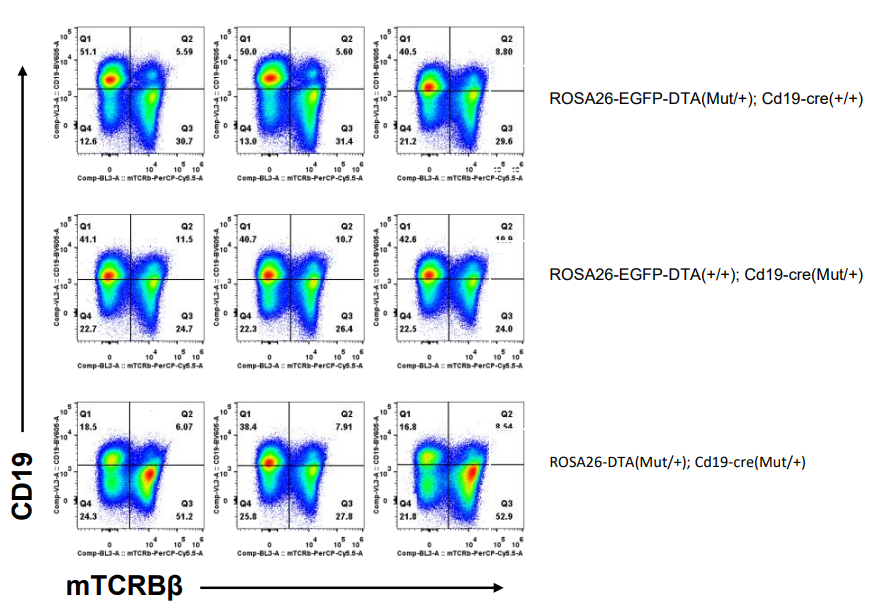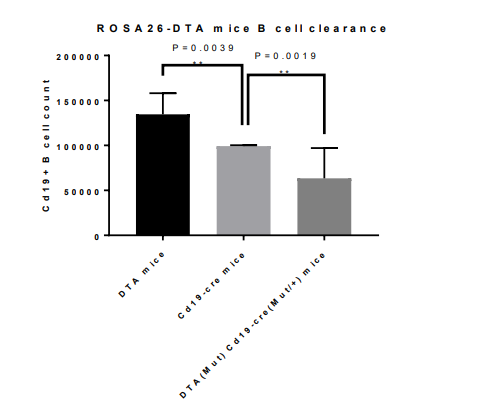Basic Information
- Function research of genes
- Deletion of specific groups of cells
Description
Homozygous mice for the targeted mutation are viable, fertile, normal in size and do not display any gross physical or behavioral abnormalities. B-ROSA26-EGFP-DTA mice have STOP cassettes preventing expression of diphtheria toxin fragment A (DTA). DTA expression will be activated, if STOP cassettes are removed – resulting in the specific ablation of the cre-expressing cells. ROSA26-EGFP-DTA mice are useful for Cre-inducible deletion of specific groups of cells.
-
Gene editing strategy

-

The ROSA26-EGFP-DTA allele has a frt-flanked STOP sequence (2xSV40 pA-lox2 stop) and a loxP-flanked STOP sequence (EGFP-Neo-3xpolyA) upstream of the diphtheria toxin A subunit (DTA) gene. After removal of the flanked STOP cassettes (2xSV40 pA-lox2 stop) by FLP-recombination, mutant mice display widespread expression of EGFP, but DTA transcription is still prevented by the strong transcriptional stop sequence(EGFP-Neo-3xpolyA). When bred to mice that express Cre recombinase under the control of a promoter of interest, the floxed-STOP cassette is removed and DTA expression is activated – resulting in the specific ablation of the cre-expressing cells. Homozygous mice are viable, normal in size, and do not display any gross physical or behavioral abnormalities. The donating investigator reports that some homozygous males are subfertile.
ROSA26-EGFP-DTA mice may be useful on their own as a fluorescent reporter, or in combination with cre-expressing mice to produce conditional deletions of specific groups of cells. ROSA26-EGFP-DTA mice may also have applications in toxicology and protein synthesis research.
-
Phenotype analysis

-


B cell from spleen, Flow cytometry analysis showed that the number of B cells specifically expressing Cre recombinase was significantly reduced in single cells of spleen, which proved that B cells specifically expressed DTA, and DTA successfully cleared B cells in spleen.
reference
- Lee PP, Fitzpatrick DR, Beard C, Jessup HK, Lehar S, Makar KW, Pérez-Melgosa M, Sweetser MT, Schlissel MS, Nguyen S, Cherry SR, Tsai JH, Tucker SM, Weaver WM, Kelso A, Jaenisch R, Wilson CB. A critical role for Dnmt1 and DNA methylation in T cell development, function, and survival. Immunity. 2001 Nov;15(5):763-74. doi: 10.1016/s1074-7613(01)00227-8. [PMID: 11728338]
2. Sawada S, Scarborough JD, Killeen N, Littman DR. A lineage-specific transcriptional silencer regulates CD4 gene expression during T lymphocyte development. Cell. 1994 Jun 17;77(6):917-29. doi: 10.1016/0092-8674(94)90140-6. [PMID: 8004678]


